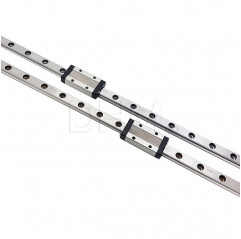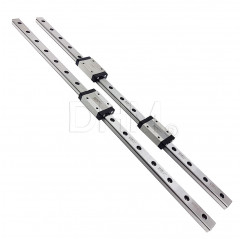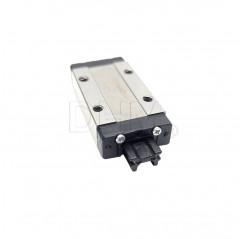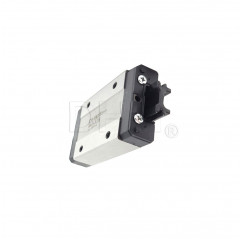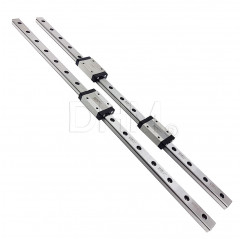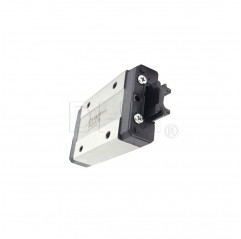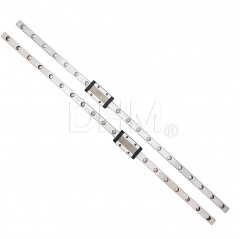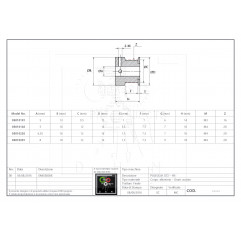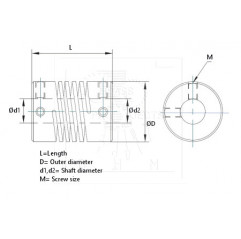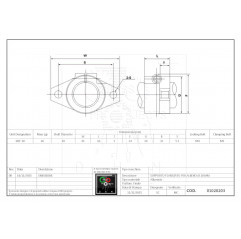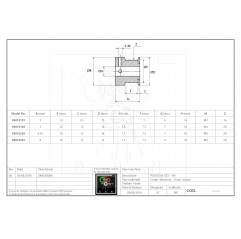Precision miniature linear guide line DHM pro. This is a thin, lightweight guide particularly suitable for precision measuring instruments, manufacturing and testing equipment, and other applications where precision linear motion is essential such as 3D printers and small CNCs.
They are also called small-scale linear guides since they are small in size.
This guide is the MGN9 model: the width of the guide is only 9 mm. The guides are supplied with an MGN9H (long skid) stainless steel skid.
Features of the linear guides DHM pro
The MGN series features guides with a compact and lightweight shape suitable for small but high-precision devices.
Comparable in technical specifications to those of leading brands such as HIWIN, Bosch Rexroth, THK, and ROLLON, the linear guides DHM pro are the professional series of our linear slides.
They feature load ratings equivalent to existing professional products on the market, and an improved radial clearance compared to the economic series that you will still find available in our e-shop.The precision and quality standards are equal to those offered by the big brands, and therefore can be safely replaced. If you are looking for an economical guide, discover the DHM series instead.
Here are the main points of the DHM pro series of MGN linear guides:
- Good vibration absorption capacity
- Compact design for mounting even in small applications
- Precision mediating effect with reduction of any error given by the mounting surface
- Installation compatibility with guides of other brands due to standard dimensions
- Two-track structure
- Low coefficient of friction
Linear guides DHM pro can withstand vertical and horizontal loads. In addition, due to the circular arc groove design, they can withstand the preload required to increase rigidity. This results in high performance, higher precision and better efficiency.
How does a linear guide DHM pro work?
A linear guide enables linear motion based on the use of balls or rollers (rolling elements). In our case through the recirculation of balls between the rail and the carriage, the linear guide enables extremely precise linear motion. The coefficient of friction of a linear guide is only 1/50 compared to that of a conventional system with SBR guide and bushing. Due to the constraints between rails and carriages, linear guideways are able to support loads in both longitudinal and transverse directions. Due to these features, linear guideways enable greatly improved motion accuracy, especially when combined with recirculating ball screws.
Specifications
Linear guides in the DHM pro line are manufactured following specific accuracies. They feature the same mounting dimensions as products offered by other brands and can therefore be used as replacements for them.
The preload ensures rigid movement of the runner blocks. There is better shock and/or vibration absorption, more precise guidance, and better ability to withstand loads. The pads have a hole for lubrication.
Material
This model of linear guide is made of 440C stainless steel. This is a stainless steel with high hardness and resistance to
corrosion. Good resistance in medium corrosive environment (atmosphere, fresh water, water vapor, crude oil,
gasoline, diesel oil, alcohol, weak acids, food products, fruit juices). The hardening and polishing to which the guides are subjected create excellent conditions for corrosion resistance.
Preload
Preload determines the stiffness of the linear guide. The higher the preload, the stiffer the guide. Loose guides can oscillate, causing noise and vibration. For example if used as guides in 3D printers any vibrations are visible later when printing directly into the object. This is why the supplied runners feature medium preload.
Cleaning and Lubrication
Lubrication is a key element in order to ensure proper functioning of recirculating ball systems. It should be carried out both when the guide is first put into operation and during the working operation of the system at periodic intervals.
Proper lubrication leads to benefits that extend the life of the entire linear system. Especially it leads to a reduction in the system of:
- Corrosion
- Friction
- Wear
- Impurities
We recommend routine maintenance of the motion system, and a step of lubrication even at first use.
We recommend cleaning the rails before lubrication. To ensure that the skid does not leak during these maneuvers you can help by putting a clamp through the last holes.
It is recommended to lubricate the rails and bearing balls with grease. Then proceed by coating the entire rail with a thin layer of grease to prevent oxidation.
The relubrication interval depends on the type of operating environment, type of load, frequency of use, and distances traveled by the skid.
The operating environment is defined as all factors external to the system, such as small chips, material
removed by abrasion, surrounding temperatures, humidity. By load type, on the other hand, we mean those factors that directly affect the system, such as shock, types of torsional loading, and vibration.
We recommend a maintenance and lubrication frequency of 6 months, or every 3 if usage is heavy or distances traveled are long. Depending on the above conditions if the grease deteriorates or becomes contaminated more quickly, it is necessary to reduce the lubrication interval according to the needs of the system.
In general, the conditions to be evaluated to schedule maintenance and lubrication of the linear system are:
- Vibration
- High operating temperatures
- Presence of condensation or any splashing of water
- Presence of special substances (vapors, acids, hydrocarbons)
- Working stroke in a short section of rail
- High dynamics of operation
Lithium grease can be used. The grease forms a film of lubricant between the steel balls and the rolling surface of the linear guides. This reduces friction and prevents jamming.
Note: Lubricants containing MoS2 (Molybdenum Bisulfide) or graphite should not be used.
Warnings
The recirculation face must not be subjected to shocks. Any shocks may affect the recirculation of the balls and cause sliding abnormalities. The balls do not fall out of the linear guides DHM pro when disassembled from the rails because the carriages are equipped with special stops. However, the balls could fall out if you quickly disassemble the carriages from the rail
or insert the rail into the carriage at an angle. Disassemble and assemble the carriages carefully.
Accuracy and radial clearance are only guaranteed when using carriages and rails from the same kit, or from the same batch. We therefore do not recommend swapping bogies and rails from the original combinations.
The accuracy of the linear rails is guaranteed after the rail has been installed, after the screws have been fastened to the rail and the rail has been pushed onto the reference plane. Rails can be installed in different ways. You can find the specifications in the dedicated guide:
Rails cannot be connected to each other in length. In case, therefore, you need a longer size, select the length most suitable for your project.
Package contains:
1 x Linear recirculating ball rail MGN9 415 mm - Stainless steel 440C
1 x MGN9 linear recirculating ball bearing slide - Stainless steel 440C






